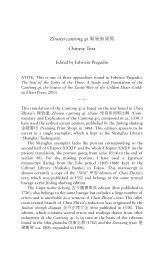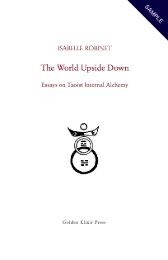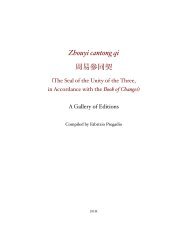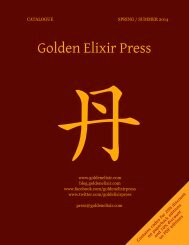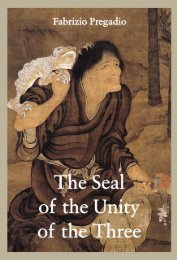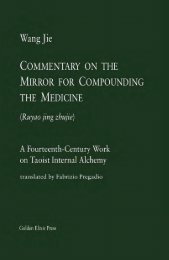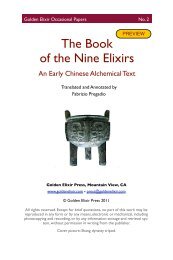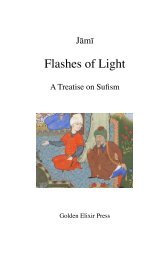The Seal of the Unity of the Three â Vol. 2 - The Golden Elixir
The Seal of the Unity of the Three â Vol. 2 - The Golden Elixir
The Seal of the Unity of the Three â Vol. 2 - The Golden Elixir
- No tags were found...
You also want an ePaper? Increase the reach of your titles
YUMPU automatically turns print PDFs into web optimized ePapers that Google loves.
3<br />
Ming and Qing Dynasties<br />
With <strong>the</strong> exception <strong>of</strong> Zhu Xi’s work, all extant commentaries to <strong>the</strong><br />
Cantong qi written through <strong>the</strong> Yuan period are related to <strong>the</strong> Taoist<br />
alchemical traditions. During <strong>the</strong> Ming (1368–1644) and <strong>the</strong> Qing<br />
(1644–1911) dynasties, <strong>the</strong> Cantong qi continued to exert its prestige<br />
on Neidan, but its influence also extended to o<strong>the</strong>r fields.<br />
Zhu Xi’s commentary inspired many literati to read <strong>the</strong> text and<br />
write commentaries, essays, and notes about it. <strong>The</strong> works by Xu Wei<br />
and Wang Wenlu during <strong>the</strong> Ming period, and those by Li Guangdi,<br />
Wang Fu, and Li Shixu during <strong>the</strong> Qing period, are representative <strong>of</strong><br />
this trend. <strong>The</strong> large number <strong>of</strong> lost commentaries and related texts—<br />
no less than three dozen during <strong>the</strong> two dynasties—is related to <strong>the</strong><br />
same phenomenon. Most <strong>of</strong> <strong>the</strong>m were never printed and, unlike <strong>the</strong><br />
Taoist and alchemical commentaries, were not intended for transmission<br />
from master to disciple. It is <strong>of</strong>ten owed only to <strong>the</strong> catalogues <strong>of</strong><br />
book collectors and to <strong>the</strong> efforts <strong>of</strong> <strong>the</strong> editors <strong>of</strong> local monographs<br />
(difang zhi 地 方 誌 ) that we know <strong>of</strong> <strong>the</strong> existence <strong>of</strong> <strong>the</strong>se works. 1<br />
Related developments occurred in two fields closely associated<br />
with one ano<strong>the</strong>r, namely cosmology and philology. One <strong>of</strong> <strong>the</strong> main<br />
compendia <strong>of</strong> traditional cosmological knowledge written during <strong>the</strong><br />
Qing period, Hu Wei’s 胡 渭 (1633–1714) Yitu mingbian 易 圗 明 辨<br />
(Clarifications on <strong>the</strong> Book <strong>of</strong> Changes and Its Charts), contains a<br />
chapter almost entirely devoted to <strong>the</strong> Cantong qi. It provides detailed<br />
information on <strong>the</strong> authorship and <strong>the</strong> history <strong>of</strong> <strong>the</strong> text, and discusses<br />
its views on cosmology with numerous quotations from commentaries<br />
and related works, especially those by Zhu Xi and by Yu<br />
Yan. 2 Philological remarks on six passages <strong>of</strong> Yu Yan’s redaction are<br />
found in <strong>the</strong> notes on <strong>the</strong> Siku quanshu that Wang Taiyue 王 太 岳 and<br />
1<br />
About a dozen lost Ming and Qing commentaries are cited only in local<br />
monographs, and nine are cited in catalogues <strong>of</strong> private libraries, especially<br />
Huang Yuji’s 黃 虞 稷 (1629–91) Qianqing zhai 千 頃 齋 in Nanjing.<br />
2<br />
Yitu mingbian, 3.1a-41b.



